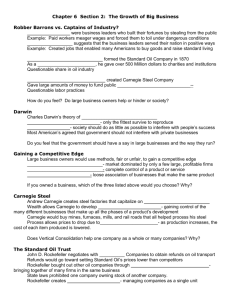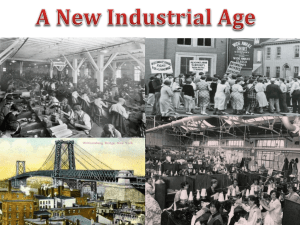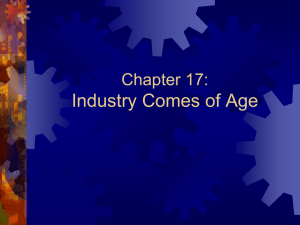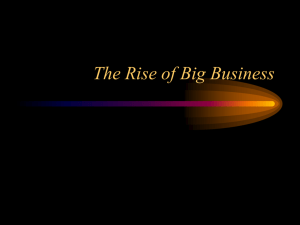EOC Review Day 3 - OCPS TeacherPress
advertisement
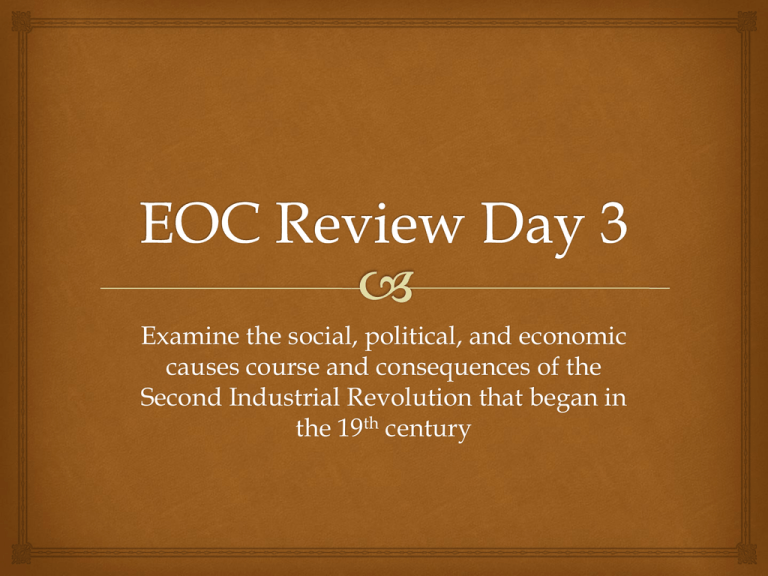
Examine the social, political, and economic causes course and consequences of the Second Industrial Revolution that began in the 19th century SS.912.A.3.3 Compare the First and Second Industrial Revolutions in the United States. SS.912.A.3.4 Determine how the development of steel, oil, transportation, communication, and business practices affected the United States economy. A. Bessemer process -1850s Turned iron into steel. Steel could now be readily produced for locomotives, steel rails, and the heavy girders used in building construction. Petroleum A. First oil well in Pennsylvania in 1859 started U.S. petroleum industry overnight. John D. Rockefeller Came from a modest background and became a successful businessman at 19. In 1870, organized the Standard Oil Co. of Ohio. By 1877, Rockefeller controlled 95% of oil refineries in U.S. Pursued a policy of rule or ruin; ruthless in his business tactics Business Practices "Vertical integration" -- controlling every aspect of the production process Pioneered by Andrew Carnegie: his steel company mined ore in Mesabi, shipped ore to his steel factory, then create their product. Goal is to improve efficiency by making supplies more reliable, controlling the quality of the product at all stages of production, and eliminate middlemen’s fees Business practices "Horizontal integration" -- Consolidating with competitors to monopolize a given market. John D. Rockefeller: Pioneered the "trust" in 1882 as a means of controlling his competition through the Standard Oil Company. Market vs Planned Market Economy-price determined by supply and demand-no government intrusion The forces of the market will even everything out Planned economy-prices and supply determined by government agencies Meant to provide affordable products to everybody Muckrakers Investigative reporters who dug up “muck” to inform the public of problems and corruption that needed fixing Upton Sinclair-The Jungle Government Regulation Supreme Court decisions Munn vs. Illinois, (1877) Decision: Public always has the right to regulate business operations in which the public has an interest; ruled against railroads Meat Inspection act-required strict cleanliness requirements Pure Food and Drug Act- 1906 forbade the manufacture or sale of mislabeled or adulterated food or drugs-led to FDA Government Regulation Federal Reserve Act-created a central banking system meant to provide the US with a sound yet flexible currency 16th Amendment-Gave the federal government the right to tax income SS.912.A.3.5 Identify significant inventors of the Industrial Revolution, including African Americans and women. B. Eli Whitney’s interchangeable parts concept now perfected by industry. Cash register, stock ticker, and typewriter facilitated business operations. Women increasingly entered the workplace to run these machines. Alexander Graham Bell’s telephone (1876) Telephone network created nation-wide within a few years. Inventors Madam C.J. Walker- invented a line of hair and beauty products for black women Thomas A. Edison Electric light (incandescent light bulb) (most famous), phonograph, mimeograph, Dictaphone, moving pictures. Genius is 1% inspiration and 99% perspiration" Invented over 1,000 inventions which were created in an invention factory through a trial and error basis. SS.912.A.3.8 Examine the importance of social change and reform in the late 19th and early 20th centuries (class system, migration from farms to cities, Social Gospel movement, role of settlement houses and churches in providing services to the poor). Urbanization Skyscrapers emerged as steel allowed for taller buildings and elevators were perfected. With the dramatic increase of population in the major cities, many problems emerged. Rampant crime: prostitution, drugs, gambling, violent crime. Unsanitary conditions persisted as cities could not keep up with growth Perfection of "dumbbell" tenement in 1879; 7 or 8 stories high with little ventilation while families were crammed into each floor (50% of New York City housing) Education Public education continued to gain strength Tax-supported elementary schools adopted on a nationwide basis before Civil War. By 1870, more and more states making at least a gradeschool education compulsory. Public high schools spread significantly by 1880s and 1890s. Illiteracy rate dropped from 20% in 1870 to 10.7% in 1900. Education in cities generally more effective than in rural America. Social Darwinism Herbert Spencer -- advocated idea of Social Darwinism Applied Darwin’s theory of natural selection to human business competition. The Gospel of Wealth -- justified uneven distribution of wealth by industrialists Andrew Carnegie: The Gospel of Wealth – it’s the duty of the rich to help the poor. Wealth was God’s will Stated money should be give away for the public good but not to individuals in want. Nativism Many Americans were alarmed at high birthrates of children of immigrants after coming to the U.S. They might over the country. More alarmed at prospect of these Southern European immigrants mixing in the American society with their "inferior" blood. Angry at immigrant willingness to work for "starvation" wages. Concerned at foreign doctrines e.g. socialism, communism and anarchism that immigrants bring. SS.912.A.3.9 Examine causes, course, and consequences of the labor movement in the late 19th and early 20th centuries. Labor Movement National Labor Union (NLU) organized in 1866 (led by William Sylvis) Major boost to the union movement. Designed to bring together skilled craft unions into one large labor union. Knights of Labor Sought to include all workers in "one big union" including blacks and women. Government regulation of railroads; postal savings banks, government paper currency Labor Movement American Federation of Labor (AF of L) Promoted a closed shop -- all workers in a unionized industry had to belong to the union. Shortcomings of the AF of L: did not represent unskilled labor; especially women and blacks. (This won’t change until the early 1900’s) Major Strikes Homestead Strike (1892) in Andrew Carnegie’s steel plant near Pittsburgh, Pennsylvania Pullman Strike, 1894 Workers went on strike and even overturned some Pullman cars. Railway traffic from Chicago to Pacific Coast was now paralyzed. Labor Movement Eugene V. Debs and his associates were sentenced to 6 months jail time for contempt of court. Debs used his time to read radical literature which laid a philosophical foundation for his later leadership of the Socialist movement in the U.S. Labor Day-The labor movement influenced Congress in 1894 to create a legal holiday to recognize the efforts of labor/workers in the United States. Thus Labor Day was established. This political cartoon is a criticism of which practice in the 19th century? A. vertical integration B. monopolization C. industrialism D. laissez-faire capitalism SS.912.A.3.11 Analyze the impact of political machines in United States cities in the late 19th and early 20th centuries SS.912.A.3.12 Compare how different nongovernmental organizations and progressives worked to shape public policy, restore economic opportunities, and correct injustices in American life.

